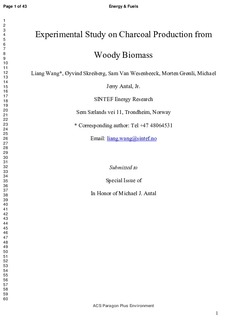| dc.contributor.author | Wang, Liang | |
| dc.contributor.author | Skreiberg, Øyvind | |
| dc.contributor.author | Van Wesenbeech, Sam | |
| dc.contributor.author | Grønli, Morten | |
| dc.contributor.author | Antal, Michael Jerry | |
| dc.date.accessioned | 2018-02-23T12:43:26Z | |
| dc.date.available | 2018-02-23T12:43:26Z | |
| dc.date.created | 2016-09-23T08:14:11Z | |
| dc.date.issued | 2016 | |
| dc.identifier.citation | Energy & Fuels. 2016, 30 (10), 7994-8008. | nb_NO |
| dc.identifier.issn | 0887-0624 | |
| dc.identifier.uri | http://hdl.handle.net/11250/2486759 | |
| dc.description.abstract | In the present work, effects of process conditions on char and fixed carbon yields from four woody biomasses were studied. The influence of the particle size, sample mass, and pressure on experimental values of char and fixed carbon yields from spruce stem wood, spruce forest residue, birch stem wood, and birch forest residue were examined in three thermogravimetric analyzers (TGAs) (two atmospheric and one pressurized) and a flash carbonizer. The obtained experimental fixed carbon yields were then compared to theoretical values calculated using the elemental composition of the studied woody biomasses. It was found that carbonization of small samples of small particles in atmospheric TGAs in an open crucible/pan offered the lowest fixed carbon yield. The yields were improved when following standard proximate analysis procedures employing closed crucibles. Further enhancement of the fixed carbon yields were obtained in the atmospheric TGAs using a crucible covered by a lid that restricts release of volatiles. Further, an increase of the pressure, particle size, and sample size gave more significant effects on char and fixed carbon yields. The largest gains were obtained as large particles were carbonized at elevated pressures. The highest char and fixed carbon yields were realized by a flash carbonizer at elevated pressure. Carbonization of spruce wood in the flash carbonizer at 2.2 MPa offered a fixed carbon yield of 28 wt %, which approaches 85% of the theoretical value. Scanning electron microscopy analyses revealed significant differences in morphology and microstructure of char particles produced under the different conditions. The spruce wood char particles produced in the flash carbonization reactor passed through a molten stage, showing a smooth and intact surface. Melting of the cell structure and recondensation/deposition of secondary carbon are more intensive at an elevated pressure. The findings presented in this work suggest that secondary reactions, involving the interaction of tarry vapors with char and conversion of them to secondary char, play a key role in charcoal formation. Char and fixed carbon yields from biomass can be considerably enhanced under process conditions that extend contacts of vapor phases with the char matrix. © 2016 American Chemical Society | nb_NO |
| dc.language.iso | eng | nb_NO |
| dc.rights | Navngivelse 4.0 Internasjonal | * |
| dc.rights.uri | http://creativecommons.org/licenses/by/4.0/deed.no | * |
| dc.title | Experimental Study on Charcoal Production from Woody Biomass | nb_NO |
| dc.type | Journal article | nb_NO |
| dc.type | Peer reviewed | nb_NO |
| dc.description.version | acceptedVersion | nb_NO |
| dc.rights.holder | Authors have copyright to accepted version | nb_NO |
| dc.source.pagenumber | 7994-8008 | nb_NO |
| dc.source.volume | 30 | nb_NO |
| dc.source.journal | Energy & Fuels | nb_NO |
| dc.source.issue | 10 | nb_NO |
| dc.identifier.doi | 10.1021/acs.energyfuels.6b01039 | |
| dc.identifier.cristin | 1384481 | |
| dc.relation.project | Norges forskningsråd: 193817 | nb_NO |
| dc.relation.project | Norges forskningsråd: 228726 | nb_NO |
| cristin.unitcode | 7548,70,0,0 | |
| cristin.unitname | Termisk energi | |
| cristin.ispublished | true | |
| cristin.fulltext | postprint | |
| cristin.qualitycode | 2 | |

